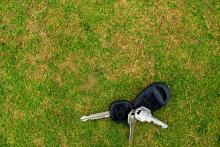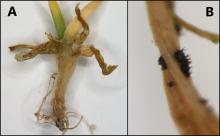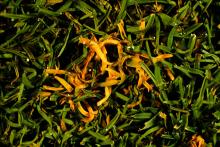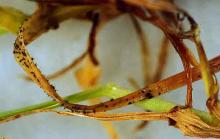Hosts Annual bluegrass is most severely affected, especially in putting green turf. Red fescue and bentgrass also are susceptible but are more resistant than annual bluegrass. This disease is not much of a problem on bentgrass in the Willamette Valley of Oregon.
Cause Spores of Colletotrichum cereale (formerly C. graminicola) spread from infected debris to turfgrass plants during warm, moist weather from late spring through summer. The disease is common but a serious problem only on plants under stress, especially late in summer during hot and humid conditions. Conditions that stress turfgrass include low mowing height, inadequate fertilization, drought stress, and extreme temperatures. Deficiencies in soil K can also result in increased anthracnose severity. Slight increases in mowing height can significantly reduce disease severity. Anthracnose severity is exacerbated when annual bluegrass putting greens are consistently subjected to wilt stress or excessively wet conditions. Sand topdressing and application of wetting agents have been shown to reduce disease activity on putting greens. Sand type (angular vs. subangular) and sand incorporation method do not appear to affect anthracnose severity. One of the problems with this disease is the small voids of bare soil that it leaves, which cause an unpredictable ball roll.
Symptoms The disease has two phases. One is the anthracnose (leaf blight) phase, active in summer; in which yellow to brown lesions appear on older leaves and sheaths. As the disease progresses, abundant fungal fruiting bodies (acervuli) covered with black hairs (setae) are on lesions. Infected areas appear in summer as irregular areas of thinned, blighted grass that are brown to yellow-tan to gray. They may be only a few inches or several feet in diameter.
The second phase is a basal stem rot usually noticed in late summer to fall in western Oregon and Washington. Older leaves begin to turn yellow at the tips, then turn a bright orange-red. Infected areas usually are small, resulting in nickel-size patches of yellow to orange plants. The bases of leaf sheaths appear darkened and separate easily from crowns.
Cultural control Promote vigorous turf growth.
Nitrogen
- Maintain adequate N fertilization to promote turfgrass vigor without overfertilizing. Apply annual N rates of approximately 3 to 4.5 lb N/1,000 sq ft.
- Begin soluble-N applications early in the season (April to May) at 0.4 to 0.8 lb N/1,000 sq ft every month to build up N prior to summer and disease development.
- If granular-N is applied, it should be applied in the spring at rates of 1 to 3 lb N/1,000 sq ft.
Potassium
- Maintain moderate soil K levels (50 to 100 ppm; Mehlich III).
- Low rate, soluble K application should be made at a 1:1 or 2:1 (N:K) molar adjusted ratio every 14 days.
Mowing and Rolling
- Avoid low mowing heights (< 0.125 in). During periods of severe stress, raise mowing heights as high as 0.140 in.
- Rolling and/or increase mowing frequency can be used to maintain ball roll distance and not increase anthracnose severity.
- Remove thatch and aerify compacted areas with a combination of vertical mowing and core cultivation.
Irrigation
- Replace 60 to 80% evapotranspiration with overhead irrigation and hand water as need to prevent severe wilt stress.
- Wetting agents applied monthly, starting in April or May, can help avoid localized dry spots.
Topdressing
- Apply sand topdressing in the summer at rates up to 100 lb/1,000 sq ft every 14 days.
- Spring topdressing is more effective at reducing anthracnose severity than fall topdressing; rates between 400 to 800 lb/1,000 sq ft in the spring can be used to reduce disease.
Soil pH
- Test soil pH routinely (every 1 to 2 years) to ensure that soil pH does not become too acidic. Limestone should be applied based on laboratory recommendations using a target pH of 6.0 and buffering capacity of the soil.
Chemical control Make the first application 3 weeks prior to first symptom development. Applications during the summer for leaf blight reduce the potential for basal rot later in the season. Also, make protective applications prior to aerification. Use higher labeled rates and adequate carrier volume to wet crown area when trying to control basal rot phase of the disease. Applications after the basal rot phase is noticed will not be effective. Granular formulations are not as effective as liquid spray applications.
Tolerant strains of many fungal pathogens can become troublesome when a single fungicide is used exclusively in a spray schedule. To prevent developing resistant fungi, alternate or tank-mix materials from different groups with different modes of action. Limit the use of any one group during crop production. Most FRAC 1 and 11 fungicides are not recommended due to widespread resistance. Do not combine FRAC 3 fungicides with growth regulators, such as Primo (trinexapac ethyl), or a brown tingeing may develop. The growth regulator effect is more pronounced during hot weather. Use FRAC 3 fungicides early and/or late in the season.
Products available in home packaging:
- BioAdvanced Fungus Control for Lawns at 32 fl oz/over 5,000 sq ft. Group 3 fungicide. H
- Bonide Infuse Systemic Disease Control Lawn and Landscape at 1.5 to 3 lb/1,000 sq ft. Activate with 0.1 to 0.25 inches water within 24 hours after application. Group 1 fungicide. H
- Infuse Systemic Disease Control at 3 fl oz/1 gal water/250 sq ft of lawn. Group 3 fungicide. H
- Spectracide Immunox Multi-Purpose Fungicide Spray Concentrate for Gardens at 7 fl oz/gal water over 500 sq ft. Group 3 fungicide. H
Products available for commercial use:
- Affirm WDG at 2.4 lb/A plus a multisite (contact) fungicide. Do not irrigate for 12 hours after application. Group 19 fungicide. 4-hr reentry.
- Chipco Signature at 4 to 8 oz/1,000 sq ft plus a multisite (contact) fungicide. Group P7 fungicide. 48-hr reentry.
- Cleary's 3336 EG at 2 to 6 oz/1,000 sq ft, depending on the phase of the disease. Resistance common on golf courses. Group 1 fungicide. 12-hr reentry.
- Compass 50 WDG at 0.15 to 0.25 oz/1,000 sq ft. Do not use organosilicate additives. Not recommended due to poor efficacy in western Oregon trials. Group 11 fungicide. 12-hr reentry.
- Daconil Weather Stik at 3 to 5.5 fl oz/1,000 sq ft. Group M5 fungicide. 12-hr reentry.
- Densicor at 8.5 fl oz/A or 0.196 fl oz/1,000 sq ft. Do not use hand held equipment. Group 3 fungicide. Reenter when sprays have dried.
- Disarm 480 SC at 0.18 to 0.36 fl oz/1,000 sq ft plus another fungicide with a different mode of activity. Group 11 fungicide. 12-hr reentry.
- Eagle 20 EW at 1.2 fl oz/1,000 sq ft. May produce a growth regulation effect on Kentucky bluegrass. Group 3 fungicide. 24-hr reentry.
- Fame SC at 0.2 to 0.4 fl oz/1,000 sq ft. Group 11 fungicide. 12-hr reentry.
- Floxcor at 0.18 to 0.36 fl oz/1,000 sq ft plus an adjuvant. Group 11 fungicide. 12-hr reentry.
- Heritage at 0.2 to 0.4 oz/1,000 sq ft. Group 11 fungicide. 4-hr reentry.
- Insignia SC at 0.4 to 0.7 fl oz/1,000 sq ft. Do not use with organosilicate adjuvants. Group 11 fungicide. 12-hr reentry.
- Maxtima at 0.4 to 0.6 fl oz/1,000 sq ft. Group 3 fungicide. 12-hr reentry.
- Medallion SC at 1 to 2 fl oz/1,000 sq ft. Apply after mowing. Use with oils or adjuvants may cause plant damage. Group 12 fungicide. 12-hr reentry.
- Mirage at 1 to 2 fl oz/1,000 sq ft. Group 3 fungicide. 12-hr reentry.
- Monsoon Turf at 0.6 fl oz/1,000 sq ft. Group 3 fungicide. 12-hr reentry.
- OHP 6672 4.5F at 2 to 5.33 fl oz/1,000 sq ft, depending on the phase of the disease. Resistance common on golf courses. Group 1 fungicide. 12-hr reentry.
- Previa at 3 to 5.5 fl oz/1,000 sq ft. Group M5 fungicide. 12-hr reentry.
- Propiconazole-based products. Group 3 fungicides.
- Banner MAXX at 1 to 2 fl oz/1,000 sq ft. Apply after mowing. 12-hr reentry.
- PropiMax EC at 0.37 to 0.73 fl oz/1,000 sq ft. 12-hr reentry.
- Rayora at 0.7 to 1.4 fl oz/1,000 sq ft. Group 3 fungicide. Reentry after sprays have dried.
- Secure at 0.5 fl oz/1,000 sq ft plus another fungicide. Not as effective as Daconil. Group 29 fungicide. Reentry when sprays have dried.
- Torque at 0.28 to 0.37 oz/1,000 sq ft. Do not mix with growth regulators during hot weather as injury may develop. Group 3 fungicide. 12-hr reentry.
- Tourney EZ at 0.28 to 0.37 oz/1,000 sq ft. Do not apply to Poa annua putting greens. Group 3 fungicide. 12-hr reentry.
- Trinity at 0.5 to 1 fl oz/1,000 sq ft. Do not mix with growth regulators during hot weather as injury may develop. Group 3 fungicide. 12-hr reentry.
- Turfcide 400 at 5 to 6 fl oz/1,000 sq ft. Irrigate with 0.25 inch water (or rainfall) immediately after application. Do not use hand application equipment. Under certain growing conditions a temporary discoloration of the grass may occur. Group 14 fungicide. 12-hr reentry.
- Velista at 0.3 to 0.5 oz/1,000 sq ft. Group 7 fungicide. 12-hr reentry.
Combination Fungicides
- Armada 50 WDG at 0.6 to 1.5 oz/1,000 sq ft. Do not use a silicone-based surfactant. Group 3 + 11 fungicide. 12-hr reentry.
- Briskway at 0.5 to 1.2 fl oz/1,000 sq ft. Can be used in hot weather without PGR injury. Group 3 + 11 fungicide. Reentry when sprays have dried.
- Concert at 4.5 to 8.3 fl oz/1,000 sq ft. Do not use on fine fescue turf. Group 3 + M5 fungicide. 12-hr reentry.
- Encartis at 3 to 4 fl oz/1,000 sq ft. Do not use with oil-based pesticides. Group 7 + M5 fungicide. Reentry when sprays have dried.
- Headway at 1.5 to 3 fl oz/1,000 sq ft. Do not use with silicone-based surfactants or EC formulations. Group 3 + 11 fungicide. 12-hr reentry.
- Heritage Action at 0.2 to 0.4 oz/1,000 sq ft. Group 11 + P1 fungicide. 12-hr reentry.
- Honor at 0.55 to 1.1 oz/1,000 sq ft. Do not use with organosilicone-based adjuvants. Group 7 + 11 fungicide. Golf course turf only.
- Lexicon at 0.34 to 0.47 fl oz/1,000 sq ft. Group 7 + 11 fungicide. 12-hr reentry.
- Navicon at 0.7 to 0.85 fl oz/1,000 sq ft. Group 3 + 11 fungicide. 12-hr reentry.
- Pillar G at 3 lb/1,000 sq ft. Group 3 + 11 fungicide. 12-hr reentry.
- Premion at 4 to 8 fl oz/1,000 sq ft. Group 3 +14 fungicide. Reentry when sprays have dried.
- Renown at 2.5 to 4.5 fl oz/1,000 sq ft. Group M5 + 11 fungicide. 12-hr reentry.
- Tartan at 1 to 2 fl oz/1,000 sq ft. Group 3 + 11 fungicide. 12-hr reentry.
Note: Some registered products offer only suppression of this disease and thus are not recommended for use. These products include Exteris Stressgard and Interface.
Plant Growth Regulators: Applications of plant growth regulators, including Primo MAXX (trinexapac-ethyl) and Proxy (ethephon), can be applied to annual bluegrass turf to improve turf quality and enhance plant health without increasing anthracnose severity. Do not combine FRAC 3 fungicides with growth regulators, such as Primo (trinexapac ethyl) otherwise over-regulation may occur.
References Crouch, J.A., Clarke, B.B., and Hillman, B.I. 2006. Unraveling evolutionary relationships among the divergent lineages of Colletotrichum causing anthracnose disease in turfgrass and corn. Phytopathology 96:46-60.
Hempfling, J.W., Schmid, C.J., Wang, R., Clarke, B.B., and Murphy, J.A. 2017. Best management practices effects on anthracnose disease of annual bluegrass. Crop Science 57:602-610.
Murphy, J.A., Clarke, B.B. and Inguagiato, J.A. 2018. Anthracnose on annual bluegrass turf: best management practices. Golf Course Manage. 02.18:76-85.




